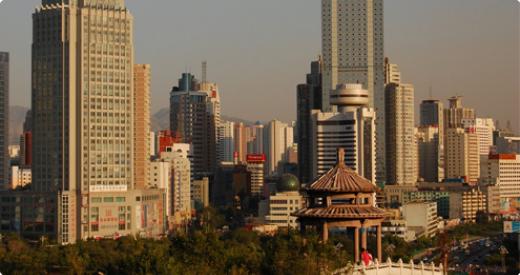
Population 2.33 million*
Cuisine Uygur, with Mongol and Islamic influences
Signature Dishes Whole roasted sheep (烤全羊); lamian (拉条子) or hand-pulled wheat noodles, often stir fried or in soup; Uyghur rice (抓饭) or rice cooked in a mutton broth with vegetables
Wine Culture Rapidly developing local grape wine production
Wine Duty Approximately 48%
Nestled in a green oasis among the lofty ice-capped Bogda Peak, the vast silver shores of the Salt Lake and the sand dunes of the Zunggar Basin rests Urumqi, the capital of Xinjiang Uyghur Autonomous Region. During the summer months of May to October, the sweet scent of flowers and melons fill the air. The city locals are the nomadic Turkic Muslim Uyghurs who travelled along the Silk Road until they settled into what is now Urumqi, established as Luntai in 648AD by the Chinese Tang dynasty. The sizeable ethnic minorities of Mongols and Kazaks still present in today’s population reflect the mixed nature of the city’s culture, all drawn to the bustling market at the end of the trading route. Dark Mongolian faces mingle together with aquiline Iranian-looking ones, alongside delicate Han Chinese features.
Urumqi’s local cuisine showcases the mix of cultures coming together in gastronomic harmony. Lamian (拉条子), fresh hand-pulled wheat noodles, are a staple food in Xinjiang, found stretched and spun from street corners to restaurants. Simply stir fried or found in soup, they are Xinjiang’s answer to Sichuan’s dan dan noodles, or Guizhou’s famous noodle soups. Naan bread (囊)is equally common however, local Uyghurs lend it their own local touch with extra salt and mold it, as opposed to hand rolling it like in India. At Ya’an Road (延安路) and Hongqi Road (红旗路), one can rub shoulders alongside Russians and dagger-wielding Kazaks for a chunk of mutton roasted over charcoal fires or a sip of yoghurt made from mare’s milk.
The city is bound together by a dominant Muslim religion. The calls to pray at the mosque still ring out through the market during the afternoons, leaving periods of silence in between the busy hum of the bustling market bazaars. The economic changes brought about by the Chinese government with the billion-yuan “Develop the West” campaign as part of the 10th Five-Year Plan from 2001 to 2005 has developed the city’s “bazaar culture”. Instead of an open air collection of rickety stalls with no organisation, huge indoor markets have replaced it. Erdaqaio, the city’s central market, now boasts nearly a million square feet and is built with towers in an Islamic style. All the glories of the Silk Road can be bought: jewel-studded daggers, locally grown melons and silk Persian carpets- even the latest iPhone! You’ll never walk away empty handed.
[* Population figure is from UN Population Division, 2011 ]









